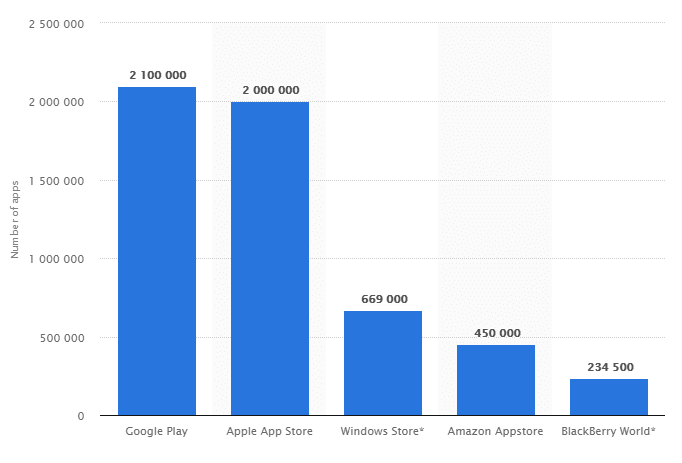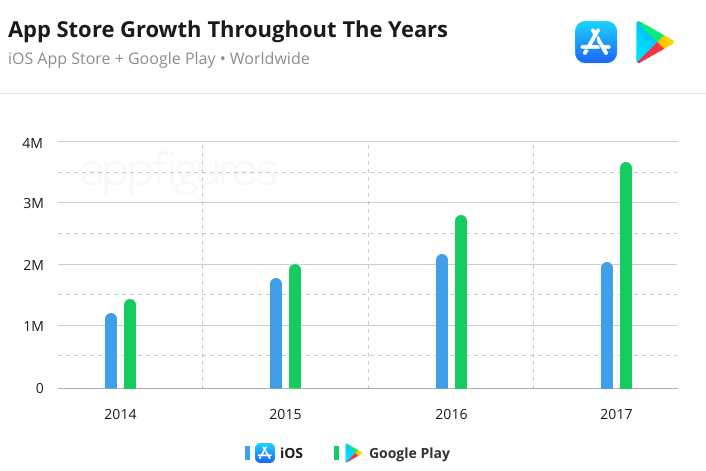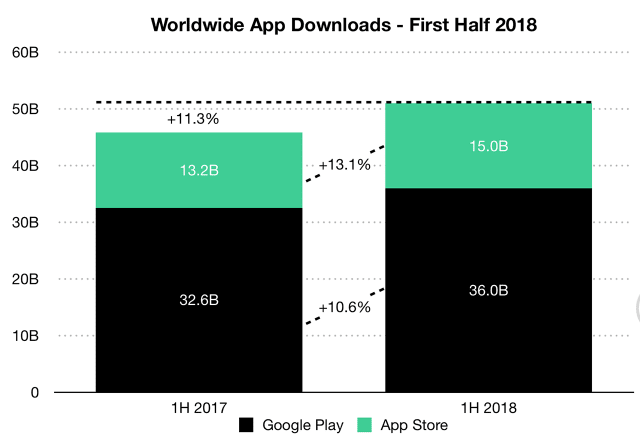iOs App Store and Google Play store are the world’s largest digital distribution platforms for mobile-based software, hosting millions of mobile applications. The Apple App Store was created by Apple to host mobile apps for its iOS operating system mainly catering to developers and consumers of products developed using Apple’s iOS Software Development Kit.
Google Play Store, launched in October 2008 under the name Android market, on the other hand, is the digital distribution channel created and operated by Google. It acts as the official app marketplace for the Android operating system, by far the world’s largest mobile OS. It enables Android App developers to develop and consumers to download mobile apps that have been created using the Android Software Development Kit (SDK).
Interesting statistics about the App Store and the Google Play store
Number of apps available
According to the latest 2018 data from Statistica, a statistics and studies website, Google Play Store leads in the number of apps available for download. Their statistics show that Google Play Store had 2.1 million apps. Apples’ App Store maintained its second position with 2 million apps.
New apps releases
Over the past few years, the number of new apps released on both Google Play and App Store has been growing steadily up until 2017 when App Store experienced its first decline in the number of new apps being released. Nonetheless, Google Play store has continued to maintain its lead and to experience a positive growth in the number of new apps being released to the market annually.
However, the number of apps in the Play Store may not necessarily translate into a win for Google. This is due to the fact that from experience, many of these apps are poor quality crappy apps. The lower number of apps in App Store can be attributed to Apple’s stringent measures meant to ensure there are no low-quality apps on its store.
Consequently, App Store has an assortment of good quality while Play Store plays host to a wide range of apps, many of which are of questionable quality. In the end, if you are a user, it’s absolutely up to you to decide whether you prefer quality to quantity or quantity to quality.
App downloads
Over the past two years, the Play Store has maintained the lead in terms of the number of apps being downloaded annually. Google Play Store has also managed to record a higher growth in the number of apps being downloaded. It recorded a 13.1% growth hitting 36B downloads versus App Store’s 10.6% growth accounting for only 15B downloads. Play Store’s higher downloads may be due to Google’s entrance into emerging markets recently and largely its bigger market share.
Listing your app on the distribution platforms
After the development of an app, the next step is getting the app listed on apps’ distribution platforms such as the Google Play Store and Apple’s App Store. Different platforms have different requirements for listing apps some more stringent than others. For example, since the inception of the App Store, the main focus of Apple has been the quality of apps and App Store has set stringent requirements that must be met. The lower number of apps on App Store as compared to Google Play Store could be a testament to this fact. As said above, due to Apple’s tight measures, only the best quality apps gain access to their app distribution platform. While this is good news for iOS users since they only get the best of the best, there is nothing to smile about for app developers. Developers have to invest time and resources to create a first-rate app to meet standards laid out by Apple.
On the other hand, the chances of your app being rejected on the Google Play Store are pretty slim. This offers developers a chance to try out and test their ideas on a much larger platform. While this may be a plus to developers who get to experiment with their ideas, it’s a genuine cause of concern for users. This is due to the fact that they have to deal with security issues as they may end up installing low-quality insecure apps.
In addition to the quality of the app, other factors such as payment/charges and sharing of income also affect app development.
Fees
If you want your app to be hosted on App Store, then you have to be willing to part with $99 per year per app. Google, on the hand, only charges a one-time fee of $25. If you are an android app developer, then this affordable fees means that you can you develop any number of apps that you are able to. Even though having high-quality apps may justify App Store’s high fees, this may limit developers, who already have the financial burden of creating high-quality apps.
Income sharing
The apps distribution platforms also generate revenue from paid apps where they take a certain percentage before passing the rest of the money to the developer. Google followed Apple’s footsteps a while back by offering app developers 85% of revenues from subscriptions up from 70%. Though they now offer the same terms as their rival, Apple, they have an added advantage: Unlike Apple which requires developers to maintain a subscriber for 12 months before the split can be made, Google’ Play Store makes the split available immediately.
Payments handling
When it comes to payments, Play Store also tries to distinguish itself from App Store by having developers handle the payments by themselves and keep all the proceeds. Apple, on the other hand, requires that any payments made within the App Store should be processed through their iTunes billing system. This is something that stills displeases many developers but have no option but to comply.
Mobile apps visibility
The visibility of the app, once it’s listed on a distribution platform, is an important factor to consider when choosing the distribution platform for your app. Different platforms have different algorithms of triggering an app to appear once a query is put. Some relying specifically on keywords while others go beyond the specific keywords.
When listing your app on Apple’s App Store provides you with a checklist to ensure that all keywords relevant to your app have been accounted for. If a person wants to search for your app, they have to type at least one of the keywords to access the app. This has the effect of decreasing visibility and consequently reducing an app’s reach as well. Apple’s App Store also employs a top-down approach. It decides which apps deserve to be in which position. To enable users to find an app, App Store promotes apps with high ratings, 4 stars and above, ranking them higher than lower ranked apps.
Google Play Store, on the other hand, employs an algorithm that works in a very similar manner to its engine. If a person inputs a query, the search results will include everything from the app down to its description and related words. Play store thus has enhanced visibility and this helps to ensure that your app easily reaches the target audience.
Conclusion
Both Google Play Store and Apple App Store have their fair share of strengths and weaknesses. It is thus essential, in addition to conducting a thorough analysis of your target market to also have a good understanding of the apps distribution platforms. These are the key factors that will not only influence the app you will develop but also the platform you will host your app on. Do not forget to also consider what you want your app to achieve before making that final decision.











Top comments (0)